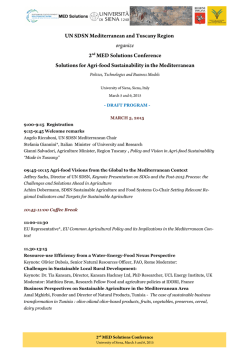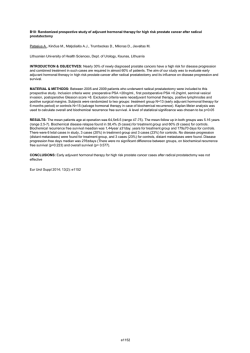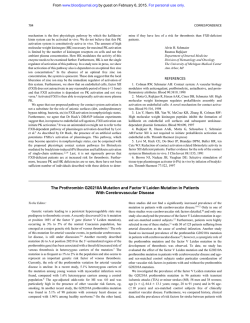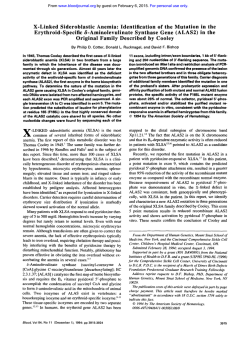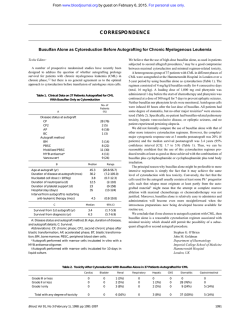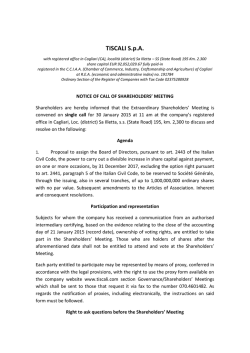
Multiple G6PD Mutations Are Associated With a Clinical and
From www.bloodjournal.org by guest on February 6, 2015. For personal use only. Multiple G6PD Mutations Are Associated With a Clinical and Biochemical Phenotype Similar to That of G6PD Mediterranean By Maria Domenica Cappellini, Franco Martinez di Montemuros, Gianluca De Bellis, Silvana Debernardi, Chiara Dotti, and Gemino Fiorelli Glucose-&phosphatedehydrogenase (GGPD) deficiency, one of the most common red cell abnormalities. is characterized by a wide clinical, biochemical, and molecularheterogeneity. In this study we have determined the molecular basis of GGPD deficiency in a sample of 70 male subjects, originating from different parts of Italy, who all shared a clinical and biochemical phenotype identical or very similar to that of G6PD Mediiterranean, the most common variant in Italy. In 59 cases (84%) we found the mutation 563 C --t T, previously known to be underlying the GGPD Mediterranean and the two polymorphic variants GGPD Cagliari and GGPD Sassari. From the remaining 11 we amplifiedthe entire coding region of G6PD in 8 different fragments and subjected them to nonradioactive single-strand conformation analysis. Direct sequencing was then performed on abnormal fragments. By this approach we found six cases (8.5%) with 1360 G --t A mutation (GGPD Union) and two cases (2.8%) with 1376 G --* C (GGPD Cosenza). In the remaining three samples we found two other mutations: 1342 A G (two cases, 2.8%) and 1052 G --t T (one case, 1.4%). These two molecular defects have never been described before and were designated by us as GGPD S. Antioco and G6PD Partenope, respectively. Haplotype analysis suggested that all the non-Mediterranean mutations occurred independently on a normal GGPD allele. This study shows that the G6PD Union mutation has a high polymorphic frequency in the Italian population and that the genetic heterogeneity of GGPD Mediterranean-like variants is higher at the molecular level than expected from biochemical characterization. 0 1996 by The American Society of Hematology. G phic variants also have similar clinical manifestations; although they are silent most of the time, they are responsible for neonatal jaundice or favism. A previous study showed that these three variants are due to the same single C -+ T transition at nt 563 (exon 6), which results in a serine to phenylalanine amino acid shift at position 188 together with a C + T mutation at nt 1311 (exon ll),’ a polymorphic site also present in approximately 20% of a normal Mediterranean p~pulation.~ Recently, Corcoran et allo described a 592‘ + mutation responsible for a G6PD Mediterranean-like variant named G6PD Coimbra, suggesting that the Mediterranean variant may have a molecular heterogeneity higher than expected from the biochemical and clinical features. Although the 563‘ + and 131 1‘ mutations have been detected in the Mediterranean variant in other the original report described this molecular abnormality only in two cases,’ and no extensive studies have been performed in a larger population in Italy. Here we report the prevalence of the nt 563 and 1311 mutations in Italian subjects having LUCOSE-6-PHOSPHATE dehydrogenase (G6PD; E.C. 1.1.1.49.) is the key enzyme of the pentose phosphate pathway and provides the NADPH essential for a number of biosynthetic and detoxifying reactions. G6PD deficiency is the most common enzymopathy of humans; originally described as a single disorder, it soon became evident that it occurs in many populations and also that its clinical manifestations vary widely, suggesting a possible biochemical heterogeneity.’ For these reasons various attempts have been made in the past to standardize the methods for measuring the kinetic properties of this intriguing enzyme.’ According to the suggested World Health Organization (WHO) o rite ria,^ so far more than 400 different G6PD variants have been described, grouped in five classes on the basis of their activity and clinical manifestations. More recently, the cloning and sequencing of the G6PD gene has prompted a search for mutations responsible for such a wide number of variants, but, to date, only approximately 80 different point mutations have been found. A relation between a single point mutation and a single biochemical variant could have been expected, but this turned out not to be the case as some of the variants previously described as biochemically distinct seem to be identical at the molecular level and vice versa various biochemical variants share the same m ~ t a t i o nStudies .~ carried out on the Italian population showed that G6PD Mediterranean is the most common variant in Italy, followed by two polymorphic variants named G6PD Cagliari and G6PD Sassari. The activities of all three variants is less than 10% of that of the normal enzyme; the residual enzyme has peculiar kinetic properties such as an increased use of substrates analogues and a low Michaelis constant for the substrate glucose-6-phosphate (G6P).5 G6PD Mediterranean, Cagliari, and Sassari are distinguishable from each other mainly by the elution peak of purified residual enzyme from a DEAE Sephadex A50 column by a KCl gradient but also by slight differences in Km values and substrates analogue utilization: The normal enzyme is eluted at 230 (22) mmol/L KC1 and G6PD Mediterranean, Cagliari and Sassari are eluted at 234 (+-3), 212 (t5), and 249 (22.5) mmol/L KCl, respectively.’ The three polymorBlood, Vol 87, No 9 (May 1). 1996 pp 3953-3958 -+ - From Cenrro Anemie Congenite, Istituto di Medicina fnterna e Fisiopatologia Medica, Universita di Milano, Ospedale Maggiore di Milano, IRCCS; Istituto di Tecnologie Biomediche Avanzate, Consiglio Nazionale delle Ricerche, Milano, Italy. Submitted March 20, 1995; accepted December 27, 1995. Supported by a grant from Progetto Finalizzato CNR Ingegneria Genetica Malattie Ereditarie to G.F. and by MURST 60%. F.M. di M. is a scholar of CNR. Presented in part at the 36th Annual Meeting of the American Society of Hematology, Nashville, TN. Address reprint requests to Maria Domenica Cappellini, MD, Istituto di Medicina Intema e Fisiopatologia Medica, Pad. Litta, Ospedale Maggiore Policlinico, IRCCS, via F. Sforza 35, 20122 Milano, Italy. The publication costs of this article were defrayed in part by page charge payment. This article must therefore be hereby marked “advertisement” in accordance with 18 U.S.C. section 1734 solely to indicate this fact. 0 1996 by The American Society of Hematology. OOO6-4971/96/8709-O021$3.O0/0 3953 From www.bloodjournal.org by guest on February 6, 2015. For personal use only. 3954 CAPPELLINI ET AL G6PD deficiency with G6PD Mediterranean-like variants, as well as the presence of four other mutations also responsible for variants with a clinical and biochemical phenotype similar to that of G6PD Mediterranean. Two of the latter have never been described in the G6PD coding region. MATERIALS AND METHODS Subjects. From January 1986 to January 1994, we collected 324 cases of G6PD deficiency. All the subjects were of Italian ancestry and most of them came to our attention because of a family history of favism, geographical origin, and/or a previous hemolytic crisis. Among them, 129 (39.8%) had a severe deficiency (activity <IO% of normal, WHO class 1 and 2), 55 (17%) a moderate deficiency (activity >15% of normal, WHO class 3), and 140 (43.2%) were female heterozygotes. Seventy of the 129 men (16 from Northern Italy, 17 from Southern Italy and 37 from Sardinia) with severe G6PD deficiency were enrolled in this study for biochemical and molecular characterization. After obtaining informed consent from each patient, 15 mL of whole blood was collected in Acid-citratedextrose, for biochemical characterization of residual enzyme and DNA analysis. Enzyme puri5cation and biochemical characterization. G6PD purification was performed as previously described, using a twostep method based on affinity chromatography on 2‘5’-ADP Sepharose 4B (Pharmacia, Uppsala, Sweden) followed by automated anion-exchange chromatography on a DEAE 5PW column (Wat e r ~ ) .Characterization ’~ of G6PD was carried out on purified enzyme preparations according to WHO and ICSH recommendations.’.’+‘The following variables were determined: activity, electrophoretic mobility (performed in three different buffers), Michaelis constants for substrates (KmG6P,K,NADP), inhibition constant (K,) for NADPH, percentage utilization of substrate analogues (2dG6P, Gal6P, dNADP), optimum pH, thermostability, KCI gradient elution peak. A mixture of equal amounts of purified enzyme from three subjects with G6PD Mediterranean, Cagliari, and Sassari was submitted to the KCI gradient as previously described.’ mutation by polymerase chain reaction Detection of 563‘ (PCR) and endonuclease cleavage. DNA was purified from leukocytes by standard methods. A 547 bp fragment encompassing exons 6 and 7 was amplified from genomic DNA by PCR with primers described previously.” The synthetic oligonucleotides were assembled on a Cyclone DNA synthesizer (Biosearch, San Rafael, CA). The amplification reaction was performed in I O mmoUL Tris-HCI pH 8.3, 1.5 mmol/L MgCI2, 200 pmoVL of each dNTP, 20 pmol of each primer in the presence of 0.5 p g of DNA, and 2.5 U of Taq polymerase (Perkin Elmer-Cetus, Nonvalk, CT) in a final volume of 50 pL. The reactions were carried out using a DNA Thermal Cycler (Perkin Elmer-Cetus) for 32 cycles as follows: denaturation at 92°C for 1 minute, annealing at 58°C for 1 minute, elongation at 72°C for 2 minutes, and a last elongation at 72°C for 10 minutes. The amplified fragment was digested overnight at 37°C with I O U of endonuclease Mboll (Amersham, UK) in order to detect the C + T transition at nt 563. Restriction fragments were analyzed on a 3% agarose gel containing ethidium bromide. PCR-single-strand conformation polymorphism (SSCP) analysis. In an attempt to detect mutations other than 563‘ in the G6PD gene, the entire coding region was PCR-amplified in eight different fragments using pairs of primers described previously.” All the amplified exons were then submitted to nonradioisotopic SSCP analysis.“,” Briefly, 3 pL of the amplified product was added to 27 p L of 92% formamide, 20 mmol/L EDTA, and 0.05% bromophenol blue, denatured at 98°C for 10 minutes, and quenched on ice for 2 minutes, Ten to 15 fiL of this mixture was loaded on a 6% to 8% polyacrylamide mini-gel (0.75 mm X 6 cm X 8 cm; acry1amide:bis - - 38:1.S), run at IS0 volts, and silver stained. The staining procedure was performed according to Bassam et allHwith some personal modifications as follows: 4 minutes in 1 % nitric acid (fixing), 2 minutes in deionized water, I O minutes in 0.2% wt/vol silver nitrate/0.037% formaldehyde (staining), 5 minutes in 3% wt/vol sodium carbonate/ 0.037% formaldehyde/0.002% sodium thiosulfate (developing), 2 minutes in 10% acetic acid (stopping). The gel was then dried for further conservation. Detection ojf31 I‘ ’ polymorphism. This silent mutation was screened by PCR-SSCP analysis of exons I O and 11 as previously described, using a positive sample determined by sequence analysis and a normal sample as markers.” DNA sequencing. A method based on the avidin-biotin system was used to obtain single-strand DNA. PCR amplification was performed using the sense biotinylated oligonucleotide CTGAGAGAGCTGGTGCTA and the anti-sense oligonucleotide GGAGAGGCATGAGGTAGC spanning a region 733 bp long encompassing exons I O to 12. The PCR product was incubated with pre-washed Dynabeads M-280 Streptavidin (Dynal, Oslo, Norway) for I O minutes at room temperature, mixing occasionally to allow almost complete binding of the biotinylated DNA fragment. The supernatant was then removed using a magnetic device to retain the beads (MPC-E, Dynal), and the remaining DNA pellet was denatured with 0.1 mol/L NaOH. After the supernatant removal, the Dynabeads-single-strand DNA complex was washed once with sterile water and finally resuspended in I O p L of distilled water. The whole Dynabedds-singlestrand DNA complex was used as template for the sequencing reaction performed with 5 pmol of the specific antisense internal fluorescent primer CATAGCCCACAGGTATGC placed 4 I bp downstream from the end of exon 11. The sequence reaction was performed by the Sanger dideoxy termination method with the Auto Read Sequencing Kit (Pharmacia LKB, Uppsala, Sweden) designed for use with the Automated Laser Fluorescent DNA Sequencer (Pharmacia LKB).”’.” Haplotype analysis. Haplotype analysis was canied out on different amplified fragments encompassing exon 4, exon 5, IVS 5 , IVS 8, and exons I O and I1 using a combination of primers previously described.” The following restriction fragment length polymorphisms were tested: NlaIII (exon 4), FokI (exon 5). PvuII (IVS 5 ) , BspHI (IVS 8). and PstI (exon 1 I). RESULTS Biochemical characterization. All 70 subjects enrolled in this study had G6PD activity lower than 10% of normal (0.3 +- 0.1 IU/gHb vs 6.05 t- 1 .O IU/gHb). On the basis of the biochemical characteristics of the enzymes, subjects were considered as carriers of the G6PD Mediterranean (27/70; 38.6%), G6PD Cagliari (29/70; 41.4%), and G6PD Sassari (14/70; 20%) variants. The means of elution peaks of our specimens were 232 ? 12, 212 ? 2.8, and 248 t- 1.4 mom KCl for the G6PD Mediterranean. Cagliari, and Sassari variants, respectively. KmG6P and analogues utilization, although less significant, were useful in distinguishing the three variants5 DNA analysis. The 563C’T mutation in exon 6, detected by PCR and MboII restriction endonuclease cleavage, was identified in 59 of 70 samples (84%). We found the expected mutation in 26 of 27 (96%) G6PD Mediterranean samples, in 21 of 29 (72%) G6PD Cagliari samples, and in 12 of 14 (86%)G6PD Sassari samples. To prove that we were dealing with truly different enzymes due to a single molecular defect and not with experimental errors, three G6PD-deficient sub- From www.bloodjournal.org by guest on February 6, 2015. For personal use only. MUTATIONS OF GGPD MEDITERRANEAN-LIKE VARIANTS 246 3955 1 2 3 4 t I- -, J 5 15 10 20 EFCLUENl (ml) Fig 1. Chromatographicprofile of a mixture of G6PD Mediterranean, Cagliari, and Sassari from a DEAE-Sephadex A-50 column with a KCI elution gradient. Fraction volume: 0.5 mL; flow rate: 0.5 mLI min. jects previously characterized as carriers of G6PD Mediterranean, G6PD Cagliari, and G6PD Sassari and having the 563"' mutation have been selected for a new biochemical characterization. The enzymes were purified as described above and the biochemical data confirmed the previous analysis. Moreover, an additional experiment was performed by mixing equal units of the three different enzymes and submitting the mixture to the KCI gradient on the DEAE-Sephadex A-50 column. The results are shown in Fig 1: three peaks were clearly distinguishable at 214. 236. and 246 mmol/L KCI for G6PD Cagliari, G6PD Mediterranean, and G6PD Sassari, respectively. The 131 IT silent polymorphism, tested by SSCP analysis (Fig 2). was found associated with the 563"' mutation in 57 of the 59 cases (97%). To search for other molecular defects in the 1 1 samples negative for the 563"' mutation, SSCP analysis was performed after amplification of the entire coding region in eight separate fragments encompassing Fig 3. PCR-SSCP analysis of a 732 bp fragment surrounding exons 10, 11, and 12. Two normal samples (lanes 3 and 4) were run alongside two G6PD-deficient samples (lanes 1 and 21 showing a marked mobility shift. A 6% polyacrylamide mini-gel (381.5 acry1amide:bis ratio) was run at 150 V for 4 hours and 30 minutes and silver stained. exons 2.4,s. 6 + 7.8.9, IO + 1 I , and IO + 12, respectively. Nine samples showed three different abnormal patterns (A, six samples: B, two samples; C, one sample) in the fragment encompassing exons I O and 1 I (Fig 2). The six samples with pattern A were submitted to sequence analysis, which revealed a I36Oc"* (exon 1 I ) base substitution. No other abnormalities were seen in other regions. This mutation has previously been described as G6PD Union" and causes an Arg to Cys amino acid shift at position 454. The G A mutation abolished a Fspl restriction endonuclease site, in fact. the normal samples were cut in two fragments of 452 bp and 45 bp, whereas the mutant samples remained undigested. In the two samples showing pattern B, sequence analysis revealed an A G mutation at nt position 1342 (exon I I), which caused a Ser to Gly replacement at position 448. Also this mutation can be proved by restriction enzyme digestion as it creates a new HnelII restriction site: one of the normal fragments (144 bp) was replaced by two other fragments of 1 15 bp and 29 bp in the presence of this mutation. In the sample with pattern C, a G T transition was revealed at nt 1052, responsible for a Gly to Trp transition at position 35 I . No restriction sites were created or abolished in this case. The 1342 and 1052 mutations have not previously been described except in abstract form and were designated by us as G6PD S. Antioco and G6PD Partenope, respectively, according to the origin of the subjects." The remaining two samples showed an abnormal pattern in the amplified fragment encompassing exons IO, I I , and 12 (Fig 3). As a 1376 mutation (G6PD Cosenza) was previously described in exon 12 by Calabrb et al in a subject of Italian origin,'" we tested our samples for this molecular abnormality. A new Ddel restriction site was created by this molecular defect, which was then tested by enzymatic digestion; the normal fragment (733 bp) was undigested. whereas the mutant was cut into fragments of 548 and 185, respectively. Both samples examined were positive for this mutation, which causes an amino acid shift 459 Arg Pro. The biochemical data and the clinical manifestations of the I 1 samples negative for the 563"T mutation are reported in Table -+ + -+ 1 2 3 4 5 6 7 8 910 I Fig 2. PCR-SSCP analysis of a 497 bp fragment encompassing exons 10 and 11. G6PD mutant samples show three different abnormal patterns: pattern A (lanes 6 to 10). pattern B (lanes 2 and 3). pattern C (lane 4). Lane 1 is a sample with the pattern of 1311T polymorphism.Lane 5 is a normal sample. Pattern A and B differ from normal in the upper bands. An 8% polyacrylamide mini-gel (381.5 acry1amide:bi.sratio) was run at 150 V for 5 hours and silver stained. -+ From www.bloodjournal.org by guest on February 6, 2015. For personal use only. 3956 CAPPELLINI ET AL C 1. All mutations and digestion patterns are summarized in Table 2. Haplotype analysis. All the G6PD samples with the Mediterranean mutation had the same haplotype (Type VII: NZaIII-/FokI -/PvuII -/&pH1 -/PstI +/BcZI +) as that commonly found in Europe and the Middle East.g," By contrast, G6PD Union, G6PD S. Antioco, G6PD Partenope, and G6PD Cosenza showed a common different haplotype (type I: NlaIII -/FokI -/PvuII -/BspHI -/Psi1 +/BcZI -) associated with the original G6PD B variant." ._ 0 ;F m .-C0 S .P .P 33t I .g .P .P .P % C C C C C C u u t Q Q T T t T t t T T T T t v v v u u v a a u u u ~ #l %%%%%SS2EE r' % c c c c c c c c ~ c c I C m - c - m o .m -+ 0 0 n c c c c c c .o " c 0 2.om 2 m~ C C C C C C u 333333ujuj2:: E L. - . - . - . - . .-g 'E g . _ . _ . _i .-.g 'f .-.% .E.E P .E .G ,E .E .m k .% DISCUSSION Identification of G6PD mutations. This paper reports the molecular characterization of 70 Italian subjects with severe G6PD deficiency, carriers of three Mediterranean-like polymorphic G6PD variants biochemically defined as Mediterranean, Cagliari, and Sassari. Although these variants are very similar, the major discriminating feature among them is the chromatographic pattern of a KC1 gradient of the purified enzyme on a DEAE-Sephadex A50 column, which segregated together with G6PD deficiency in family pedigree studies and proved to be indicative in the control experiment carried out in this ~ o r k . ~ , ~The , ~ "rationale '~ of the present study was to establish if the 563 C -+ T mutation, described for all the three Mediterranean-like variants8 was really the unique molecular defect and/or if other mutations could be involved as a series of recent papers have shown that different G6PD biochemical variants share the same DNA mutation and vice versa that the same molecular abnormality may be responsible for different biochemical phenotype^.'.^ In the present extended study we identified five point mutations associated with the Mediterrenean, Cagliari, and Sassari variants. Three of these base substitutions have thus far been found in the Italian population: the 563 C + T referred to as the "original" Mediterranean mutation,' the 1360 C + T originally described for variants G6PD Union and G6PD Maewo in Oriental populations,22*28 and the 1376 G C responsible for G6PD Cosenza in Southern Italy.24The 1052 G -+ T and 1342 A + G substitutions are new findings. The first was observed in two subjects who had clinical history of favism, originating from S. Antioco, a little island of South Sardinia, carrying the G6PD Cagliari variant. The second was identified in a subject born in Naples, who had neonatal jaundice and several episodes of acute hemolytic crisis triggered by different causes, also carrying the biochemical variant G6PD Cagliari. Since the name G6PD Napoli has already been used to define a biochemical sporadic variant detected in this area,29to avoid misunderstandings we designated our mutation G6PD Partenope from the ancient name of the city. Surprisingly, among the 11 samples negative for the Mediterranean mutation, 8 had the G6PD Cagliari biochemical phenotype, whereas only1 had the G6PD Mediterranean and 2 the G6PD Sassari. The five DNA defects described in this study, indicate a molecular heterogeneity higher than expected for the G6PD Mediterraneanlike variants in Italy, mainly for GBPD Cagliari. The fact that different point mutations cause identical or very similar enzymatic phenotypes raises intriguing questions. Interestingly, this phenomenon has been observed also for G6PD 0001 I - m m 0 c P U 'j E L '- miS t 0 3 E -m '*0 e 855 U I S S ~ Z S S S S S ~ ~ ~ .gE .BE .gE .BE .EE .gE .FE b c .U e c c c aaapaaaaal € E .L? .L? -m ;g g t#< g g g g g g g g g g g ! E f z .-c 4 I .E lp E P A J J A J - l J - I J d A Z 'o 0 5 0 5 .o 'o .o 'o 'o '$ 0 0 'I 0 0 '$ 0 0 '$ 0 0 'I 0 0 -m m m l U m m m t O m 6 m m E r r r r c r r r r r r gsggc?sggg.ggg 3 -e gi e g g g g s c z $ g $ ; O N U ) l r r N m ( D B 1 Q Q) tzzzzzzzt;;g 0 ui v) 4 iE o 8 .pgn~~c~$rQ$~rQ+l S1 -S r (D"roz -10 0 - 9 (D m 0 P 8 E E c c B f n 'E 2s ' y ~ o N * m o r N ? r ~ ~ ~ ~ ~ x z m i kg U 0 55 9"9Y'ot'9':+1 RRL:IEMRIzmo r ?I! f -ui g w -8 i 332 E ! 28c 8" r8c8r 8r r8c8c 6 8 8 3% Y = $2 N g N= N pN ~ N N Pf c e W ~ " w 0 y q y q q r N m m N r * * N r N :: Eg ; se CS S E q NgN =N = t l N X~ ab ;e ;;;g N c c 0 .- .-:g i ( 8 Eb P- f 3: - 2 Q 5 .E3 ~ g ~ m a $ $ $ $ $ ~ i + l ti r N m * m " m m O r - l "E 2$ g: g .-:: .m p1 Q $ 5 * z b a* L ? From www.bloodjournal.org by guest on February 6, 2015. For personal use only. MUTATIONS 3957 OF G6PD MEDITERRANEAN-LIKE VARIANTS Table 2. Datection of Mutations by Endonuclease Cleavage Fragment Size (bpl No. of GGPD Variant Mutation Exon Cases Enzyme Uncut Cut (normal) Cut (mutant) Mediterranean Union Cosenza S. Antioco 563 C T 1360C-T 1376 G C 1342A-G 6 11 12 11 59 6 2 2 Mboll FspI Ddel Haelll 547 497 733 497 377, 119, 26, 25 452,45 733 144, 130, 70, 67, 30, 25, 18, 12, 6 277, 119, 100,26,25 497 548, 185 130, 115, 70, 67, 30, 29, 25, 18, 12, 6 Partenope 1052 G 10 1 - 497 - - - + - T A-, which was generally regarded as a distinct homogeneous mutation but then proved to be the result of the superimposition of several point substitutions on the background of G6PD A376G.30 The original Mediterranean mutation (563T) remains the most common among the Italian population and has been found also in many other ethnic groups.'@'' The original G6PD Union mutation (1360 C T) also turned out to be frequent in the Italian population among the Mediterranean-like variants. Relationship between mutations and enzyme structure. To date only one mutation placed at nt 592 (G6PD Coimbra) other than the five reported in this paper has been identified as responsible for a phenotype similar to that of G6PD Mediterranean." For this molecular defect, as the distance from nt 563 is only 29 nucleotides, resulting in 10 amino acids at the protein level, it could have been hypothesized that alterations in this part of the gene could lead to similar biochemical properties affecting the surrounding G6P binding site, which was supposed to be around nt 594-615.3'-32 The new finding that mutations in exons 10, 11, and 12 are responsible for a similar phenotype is in contrast with this hypothesis and suggests that more complex interactions exist for this protein. In view of the recent crystallization of G6PD from Leuconostoc mesenteroides and modelling of the tertiary structure of human G6PD we observed that four of five amino-acidic substitutions detected in this work (188 Ser Phe, 448 Ser -+ Gly, 454 Arg --* Cys, 459 Arg Pro) and the 198 Arg Cys (G6PD Coimbra) fall close to the substratebinding site identified to be a nonapeptide (aa 198-206) conserved in several G6PD specie^.^*-^^ This observation could at least, in part, explain why different molecular defects share similar biochemical phenotypes. However, it remains unexplained why amino acid changes in different domains of the tertiary structure should be responsible for similar biochemical properties as in the case of the 351 Gly Trp. Again, a similar behavior has been reported for G6PD A-, common among Africans, which is determined by the 376* + G mutation associated with three different second mutations: 202A, 680T, and 968C. Recent studies demonstrated that the enzyme activity is not affected unless the nt 376 mutation is pre~ent.'~ The three-dimensional data have suggested the interaction between amino acid residues 68 (nt 202) and 126 (nt 376), but cannot yet explain what happens when other molecular abnormalities are involved.33These results suggest that the biochemical properties of G6PD may be conditioned by the three-dimensional structure of the protein but on the other hand strongly support the hypothesis -+ + -+ + -+ that some genetically determined extragenic factor or post translational modification could play a role in causing the specific behavior of G6PD deficiency. This could explain also the opposite situation, more frequently observed, in which different biochemical variants have the same molecular defect; for example, in the case of G6PD Dallas and G6PD Birmingham, they are biochemically distinct from G6PD Mediterranean, Cagliari, and Sassari, but have the same 563T mutation? Haplotype and SSCP analysis. In order to obtain further insights on the origin and spread of the different mutations responsible for the G6PD Mediterranean-like variants, we performed haplotype analysis according to Vulliamy et al.25*35 Interestingly, in our samples we found a strong linkage between mutation 563T and haplotype VII, previously reported in subjects of African origin also carrying the G6PD Mediterranean mutation.' By contrast, mutations other than 563, in our hands, were linked to haplotype I, which is peculiar to normal G6PD B. Since G6PD B is the starting point of the evolutionary tree of the G6PD gene, as it is found also in the ~himpanzee,~' we may speculate that the mutations at nt 1052, 1342, 1360, and 1376 occurred independently on a normal G6PD B allele. The sequential order of these is difficult to assess without testing the new mutations and their linkage with different haplotypes in more samples. Finally, from the technical point of view, this study shows the validity of the SSCP/silver staining method in detecting G6PD DNA abnormalities. Four bands are detectable for each single amplified denatured fragment, suggesting that each single strand may present more than one conformation, and therefore, that mutations can affect one or more of these conformations causing different migration patterns. This method allowed us to detect different patterns in all 11 samples with unknown molecular defect. Furthermore, with our modifications, silver staining is fast and sensitive; only 1/ 25th of the amplified product is necessary for satisfactory staining, which could be performed in about 20 minutes. REFERENCES 1. Luzzatto L, Metha A: Glucose-6-phosphate dehydrogenase deficiency, in Scriver CR, Beaudet AL, Sly WS, Valle D (eds): The Metabolic Basis of Inherited Disease. London, McGraw-Hill, 1988, p 2237 2. Beutler E: Study of glucose-6-phosphate dehydrogenase: History and molecular biology. Am J Hematol 4253, 1993 3. Betke K, Beutler E, Brewer GJ, Kirkman HN, Luzzatto L, From www.bloodjournal.org by guest on February 6, 2015. For personal use only. 3958 Motulsky AG, Ramot B, Siniscalco M: Standardization of procedures for the study of glucose-6-phosphate dehydrogenase. Report of a WHO scientific group. WHO Tech Rep Ser 366, 1967 4. Beutler E: G6PD deficiency. Blood 843613, 1994 5. Fiorelli G , Manoussakis C, Sampietro M, Pittalis S, Guglielmino CR, Cappellini MD: Different polymorphic variants of glucose-6-phosphate dehydrogenase (G6PD) in Italy. Ann Hum Genet 53:229, 1989 6. D’Urso M, Battistuzzi G, Luzzatto L: Genetic variants of human erythrocyte glucose-6-phosphate dehydrogenase: Automated procedure for characterization by column chromatography. Anal Biochem 108:146, 1980 7. Fenu MP, Finazzi G, Manoussakis C, Palomba V, Fiorelli G: Glucose-6-phosphate dehydrogenase deficiency: Genetic heterogeneity in Sardinia. Ann Hum Genet 46:105, 1982 8. De Vita G. Alcalay M, Sampietro M, Cappellini MD, Fiorelli G, Toniolo D: Two point mutations are responsible for G6PD polymorphism in Sardinia. Am J Hum Genet 44:233, 1989 9. Beutler E, Kuhl W: The NT 131 I polymorphism of G6PD: G6PD Mediterranean mutation may have originated independently in Europe and Asia. Am J Hum Genet 47:1008, 1990 10. Corcoran CM, Calabrb V, Tamagnini G, Town M, Haidar B, Vulliamy TJ, Mason PJ, Luzzatto L: Molecular heterogeneity underlying the G6PD Mediterranean phenotype. Hum Genet 88:688, 1992 1 1 . Kurdi-Haidar B, Mason PJ, Berrebi A, Ankra-Badu G, AlAli A, Oppenheim A, Luzzatto L: Origin and spread of the glucose6-phosphate dehydrogenase variant (G6PD-Mediterranean) in the Middle East. Am J Hum Genet 47:1013, 1990 12. Oppenheim A, Jury CL, Rund D, Vulliamy TJ, Luzzatto L: G6PD Mediterranean accounts for the high prevalence of G6PD deficiency in Kurdish Jews. Hum Genet 91:293, 1993 13. Pittalis S, Martinez di Montemuros F, Tavazzi D, Fiorelli G: Rapid isolation of glucose-6-phosphate dehydrogenase from human erythrocytes by combined affinity and anion-exchange chromatography for biochemical characterization of variants. J Chromatogr 573:29, 1992 14. Beutler E, Blume KG, Kaplan PC, Lohr GN, Ramot B, Valentine WN: International Committee for Standardization in Haematology. Recommended methods for red cell enzyme analysis. Br J Haematol 35:331, 1977 15. Poggi V. Town M, Foulkes NS, Luzzatto L: DNA sequence abnormalities of human glucose-6-phosphate dehydrogenase gene by PCR amplification of the entire coding region from genomic DNA. Biochem J 271:157, 1990 16. Orita M, Suzuki Y, Sekiya T, Hayashi K: Rapid and sensitive detection of point mutations and DNA polymorphisms using the polymerase chain reaction. Genomics 5:874, 1989 17. Ainsworth PJ, Surch LC, Coulter-Mackie MB: Diagnostic single-strand conformation polymorphism (SSCP): A simplified nonradioisotopic method as applied to a Tay-Sachs BI variant. Nucleic Acids Res 19:405, 1991 18. Bassam BJ, Caetano-AnollCs G, Gresshoff PM: Fast and sensitive silver staining of DNA in polyacrylamide gels. Anal Biochem 196:80, 1991 19. Martinez di Montemuros F, Cappellini MD, Dotti C, Tavazzi D, De Bellis G, Debernardi S, Fiorelli G: Molecular characterisation CAPPELLINI ET AL of an Italian G6PD variant responsible for chronic non-spherocytic haemolytic anaemia. Clin Genet 46:357, 1994 20. Sanger F, Nicklen S, Coulson AR: DNA sequencing with chain terminating inhibitors. Proc Natl Acad Sci USA 745463, 1977 21. Ansorge W, Sproat B, Stegemann J, Schwager C, Zenke M: Automated DNA sequencing: Ultrasensitive detection of fluorescent bands during electrophoresis. Nucleic Acids Res 15:4593, 1987 22. Rovira A, Vulliamy TJ, Pujades A, Luzzatto L, Corrons JL: The glucose-6-phosphate dehydrogenase (G6PD) deficient variant G6PD Union (454 Arg Cys) has a worldwide distribution possihly due to recurrent mutation. Hum Mol Genet 3:833, 1994 23. Cappellini MD, Martinez di Montemuros F. Dotti C, Tavazzi D, De Bellis G, Debemardi S, Fiorelli G: Molecular heterogeneity of glucose-6-phosphate dehydrogenase (G6PD) Mediterranean type in Italy. Blood 84:114a, 1994 (abstr, suppl I) 24. Calahro V, Mason PJ, Filosa S, Civitelli D, Cittadella R, Tagarelli A, Martini G, Brancati C, Luzzatto L: Genetic heterogeneity of glucose-6-phosphate dehydrogenase deficiency revealed by single-strand conformation and sequence analysis. Am J Hum Genet 52527, 1993 25. Vulliamy TJ, Othman A, Town M, Nathwani A, Falusi Y, Luzzatto L: Linkage disequilibrium sites in the G6PD gene in African populations and the origin of G6PD A-. Gene Geography 5: 13. 1991 26. Luzzatto L, Allan NC: Different properties of glucose-6-phosphate dehydrogenase from human erythrocytes with normal and abnormal enzyme levels. Biochem Biophys Res Commun 21 547. I965 27. Testa U, Meloni T, Lania A, Battistuzzi G, Cutillo S, Luzzatto L: Genetic heterogeneity of glucose-6-phosphate dehydrogenase deficiency in Sardinia. Hum Genet 56:99. 1980 28. Beutler E, Westwood B, Kuhl W, Hsia YE: Glucose-h-phosphate dehydrogenase variants in Hawaii. Hum Hered 42:327. 1992 29. De Flora A, Morelli A, Ben& U, Giuntini P, Ferraris AM, Galiano S, Ravazzolo R. Gaetani GF: G6PD Napoli and Ferrara 11: Two new glucose-6-phosphate dehydrogenase variants having similar characteristics but different intracellular lability and specific activity. Br J Haematol 48:417, 1981 30. Beutler E. Kuhl W, Vives-Corrons JL, Prchal JT: Molecular heterogeneity of G6PD A-. Blood 742550, 1989 3 I . Camardella L, Caruso C, Rutigliano B, Romano M, Di Prisco G, Descalzi-Cancedda F: Human glucose-6-phosphate dehydrogenase. Identification of a reactive lysil residue labelled with pyridoxal 5’-phosphate. Eur J Biochem 171 :485, 1988 32. Rowland P, Basak AK, Gover S, Levy HR, Adams MJ: The three-dimensional structure of glucose-6-phosphate dehydrogenase from Leuconostoc mesenteroides refined at 2.0 A resolution. Structure 2: 1073, 1994 33. Mason PJ, Vulliamy TJ, Bautista JM, Luzzatto L, Naylor C. Adams M: The three dimensional structure of G6PD helps to explain G6PD deficiency. Blood 84:14a, 1994 (abstr, suppl I ) 34. Town M, Bautista JM, Mason PJ, Luzzatto L: Both mutations in G6PD A- are necessary to produce the G6PD deficient phenotype. Hum Mol Genet 3:171, 1992 35. Vulliamy TJ, Othman A, Town M, Nathwani A, Falusi AG, Mason PJ, Luzzatto L: Polymorphic sites in the African population detected by sequence analysis of the glucose-6-phosphate dehydrogenase gene outline the evolution of the variants A and A-. Proc Natl Acad Sci USA 88:8568, 1991 + From www.bloodjournal.org by guest on February 6, 2015. For personal use only. 1996 87: 3953-3958 Multiple G6PD mutations are associated with a clinical and biochemical phenotype similar to that of G6PD Mediterranean MD Cappellini, F Martinez di Montemuros, G De Bellis, S Debernardi, C Dotti and G Fiorelli Updated information and services can be found at: http://www.bloodjournal.org/content/87/9/3953.full.html Articles on similar topics can be found in the following Blood collections Information about reproducing this article in parts or in its entirety may be found online at: http://www.bloodjournal.org/site/misc/rights.xhtml#repub_requests Information about ordering reprints may be found online at: http://www.bloodjournal.org/site/misc/rights.xhtml#reprints Information about subscriptions and ASH membership may be found online at: http://www.bloodjournal.org/site/subscriptions/index.xhtml Blood (print ISSN 0006-4971, online ISSN 1528-0020), is published weekly by the American Society of Hematology, 2021 L St, NW, Suite 900, Washington DC 20036. Copyright 2011 by The American Society of Hematology; all rights reserved.
© Copyright 2025
